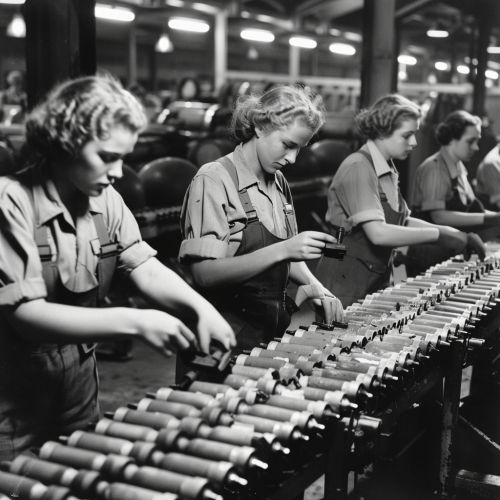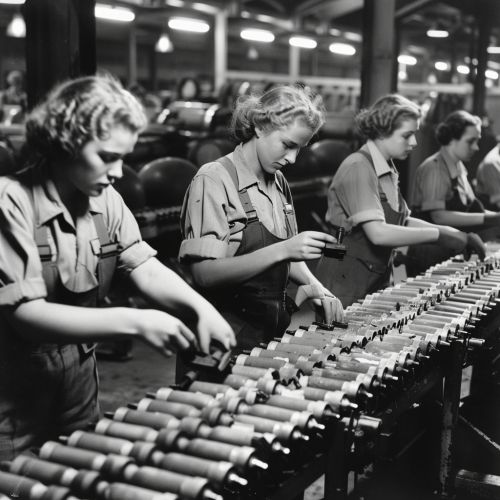Home front during World War II
Home Front During World War II
The home front during World War II was a crucial aspect of the war effort, encompassing the activities and contributions of civilians in the Allied and Axis nations. This period saw significant changes in social, economic, and political structures as countries mobilized all available resources to support their military forces. The home front was characterized by increased industrial production, rationing, propaganda, and shifts in gender roles.
Industrial Production
The war effort required a massive increase in industrial production to supply the military with weapons, vehicles, and other essential materials. In the United States, the War Production Board was established to oversee the conversion of peacetime industries to war production. Factories that once produced consumer goods were retooled to manufacture tanks, airplanes, and ammunition. The United Kingdom implemented similar measures, with the Ministry of Supply coordinating the production of war materials.


In Germany, the Four Year Plan aimed to prepare the economy for war, emphasizing autarky and the production of synthetic materials. The Soviet Union also saw a significant increase in industrial output, with factories being relocated to the east to avoid German advances. The Lend-Lease Act allowed the United States to supply its allies with critical materials, further boosting production on the home front.
Rationing and Resource Management
Rationing was implemented in many countries to ensure that resources were distributed fairly and that the military had sufficient supplies. In the United States, the Office of Price Administration controlled prices and rationed goods such as gasoline, rubber, and food. Citizens were issued ration books and encouraged to grow "victory gardens" to supplement their food supply.
In the United Kingdom, rationing began in 1940 and included items such as meat, sugar, and clothing. The government promoted the "Dig for Victory" campaign to encourage self-sufficiency in food production. Germany also implemented rationing, with the Reich Food Estate controlling the distribution of agricultural products.
Propaganda and Morale
Governments used propaganda to maintain public morale and support for the war effort. In the United States, the Office of War Information produced films, posters, and radio broadcasts to promote patriotism and encourage participation in war-related activities. The British Broadcasting Corporation (BBC) played a similar role in the United Kingdom, providing news and entertainment to boost morale.
In Germany, the Ministry of Public Enlightenment and Propaganda, led by Joseph Goebbels, controlled the media and disseminated messages to maintain support for the Nazi regime. The Soviet Union used propaganda to promote the idea of the "Great Patriotic War" and encourage resistance against the German invasion.
Gender Roles and Workforce Changes
The war led to significant changes in gender roles, as women entered the workforce in unprecedented numbers to replace men who had gone to fight. In the United States, the iconic figure of Rosie the Riveter symbolized the contributions of women in industries such as aircraft manufacturing and shipbuilding. The Women's Army Corps (WAC) and other auxiliary services allowed women to serve in non-combat roles, further expanding their participation in the war effort.
In the United Kingdom, women joined the Women's Land Army to work in agriculture and the Auxiliary Territorial Service (ATS) to support the military. The Soviet Union saw women serving in combat roles, including as pilots and snipers, reflecting the desperate need for manpower.
Civil Defense and Community Efforts
Civil defense measures were implemented to protect civilians from air raids and other threats. In the United Kingdom, the Air Raid Precautions (ARP) organization coordinated efforts to build bomb shelters, enforce blackout regulations, and provide first aid. The Blitz saw extensive bombing of British cities, leading to significant civilian casualties and damage.
In the United States, the Civil Air Patrol and other organizations trained volunteers to spot enemy aircraft and assist in emergency situations. Germany's Luftschutz (air protection) program focused on building shelters and training civilians in air raid procedures.
Economic and Social Impact
The war had profound economic and social impacts on the home front. In the United States, the war effort led to the end of the Great Depression as industrial production surged and unemployment fell. The G.I. Bill provided returning soldiers with education and housing benefits, contributing to post-war economic growth.
In the United Kingdom, the war led to the establishment of the welfare state, with the Beveridge Report laying the groundwork for social reforms such as the National Health Service. Germany faced severe economic challenges, with widespread destruction and shortages of basic goods.
The war also led to significant social changes, including the migration of African Americans to northern cities in the United States in search of employment, known as the Great Migration. The internment of Japanese Americans reflected the racial tensions and suspicions that arose during the war.
Post-War Reconstruction and Legacy
The end of World War II brought about the need for extensive reconstruction on the home front. In Europe, the Marshall Plan provided aid to rebuild economies and infrastructure, while the United Nations was established to promote international cooperation and prevent future conflicts.
The war left a lasting legacy on the home front, with changes in gender roles, economic structures, and social policies continuing to shape societies in the post-war era. The experiences of civilians during the war highlighted the importance of resilience and adaptability in the face of global conflict.
